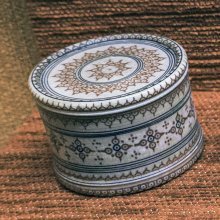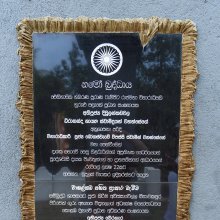Laksha, Lākṣā: 28 definitions
Introduction:
Laksha means something in Buddhism, Pali, Hinduism, Sanskrit, Jainism, Prakrit, Marathi, Hindi. If you want to know the exact meaning, history, etymology or English translation of this term then check out the descriptions on this page. Add your comment or reference to a book if you want to contribute to this summary article.
The Sanskrit term Lākṣā can be transliterated into English as Laksa or Laksha, using the IAST transliteration scheme (?).
Images (photo gallery)
In Hinduism
Ayurveda (science of life)
Toxicology (Study and Treatment of poison)
Source: Shodhganga: Kasyapa Samhita—Text on Visha ChikitsaLākṣā (लाक्षा) refers to an ingredient which is included in a (snake) poison antidote recipe, according to the Kāśyapa Saṃhitā: an ancient Sanskrit text from the Pāñcarātra tradition dealing with both Tantra and Viṣacikitsā—an important topic from Āyurveda which deals with the study of Toxicology (Viṣavidyā or Sarpavidyā).—In the Añjana or Collyrium segment of the eighth Adhyāya, Kāśyapa prescribes eight types of permutation and combination of herbs that effectively arrest poison. According to Kāśyapasaṃhitā (verse VIII.37)—“A combination of Śiriṣa, Elā, Niśā, Lac (lākṣā), Māṃsī, Yaṣṭhi, Mustard, salt, Trivṛt, Yaṣṭhi, Viśālā, Trikaṭu, two varieties of Niśā, with Madhu and Māñjiṣṭhā placed in the cow’s horn form a formidable drug to eliminate venom”.
Rasashastra (Alchemy and Herbo-Mineral preparations)
Source: History of Science in South Asia: Making Gems in Indian Alchemical LiteratureLākṣā (लाक्षा) refers to “lac” and is used in the recipe for Matsyakajjala (“fish black”), according to the Vādakhaṇḍa section of the Rasaratnākara (lit. “jewel mine of mercury”): a 13th century alchemical work in Sanskrit written by Nityanātha.—Accordingly, while describing the recipe for Matsyakajjala (“fish black”): “Rub lac (lākṣā) with four times its amount of water; take 4,8 litres of this liquid, filtered through a cloth, and boil it in an earthen vessel on low heat, until a fourth of it remains. Add 48 g each of powdered Natron, Borax, and Lodhra. Heat it a bit. Then, once it has cooled down, pour it into a glass bottle. Cook the skin of a fat fish for a day and night with this water. When it has thickened, remove it. This is known as ‘fish black’”.
Unclassified Ayurveda definitions
Source: Wisdom Library: Āyurveda and botany
Lākṣā (लाक्षा) is a Sanskrit word referring to lac produced by Coccus lacca (or, Kerria lacca), an insect from the Kerriidae family of scale insects. It is used throughout Ayurvedic literature such as the Caraka-saṃhitā. It is found in trees such as Butea frondosa, a tropical tree from the Fabaceae (legume) family of flowering plants. ‘Lac’ refers to the resinous secretion of the above mentioned insect, which is cultivated for its use as a dye or in cosmetics.

Āyurveda (आयुर्वेद, ayurveda) is a branch of Indian science dealing with medicine, herbalism, taxology, anatomy, surgery, alchemy and related topics. Traditional practice of Āyurveda in ancient India dates back to at least the first millenium BC. Literature is commonly written in Sanskrit using various poetic metres.
Shaktism (Shakta philosophy)
Source: Google Books: ManthanabhairavatantramLakṣa (लक्ष) refers to “100,000” (repetitions of mantra), according to the Manthānabhairavatantra.—Accordingly, “From the root (of all things) Śāmbhavīśakti is Bhairavī the energy that is full (bharitā) (of all the energies). [...] She generates the energy of eternal bliss and has merged into the Bliss of Stillness (nirānanda—i.e. Śiva). Blissful and delighted, she is satisfied and her form is blissful. She is the supreme Command and her form is the Void. She pierces through the moving and immobile (universe). Her nature is the Void (vyomarūpā) and she resides within the secret Void. The energy that utters itself, she abides as 100,000 repetitions of mantra [i.e., lakṣa-jāpya]. She is Kāmeśvarī who, as the power of the will (kāmaśakti), has comes forth from the centre of the Point”.

Shakta (शाक्त, śākta) or Shaktism (śāktism) represents a tradition of Hinduism where the Goddess (Devi) is revered and worshipped. Shakta literature includes a range of scriptures, including various Agamas and Tantras, although its roots may be traced back to the Vedas.
Jyotisha (astronomy and astrology)
Source: Wisdom Library: Brihat Samhita by VarahamihiraLākṣā (लाक्षा) refers to “lac”, according to the Bṛhatsaṃhitā (chapter 10), an encyclopedic Sanskrit work written by Varāhamihira mainly focusing on the science of ancient Indian astronomy astronomy (Jyotiṣa).—Accordingly, “If the course of Saturn should lie through the constellation of Viśākhā, the Trigartas, the Chinese and the Kulūtas, saffron, lac [i.e., lākṣā], crops and everything of bright, red or crimson colour will suffer. If the course of Saturn should lie through the constellation of Anurādhā, the Kulūtas, the Taṅgaṇas, the Khasas, the people of Kāśmīra, ministers, drivers and bell-ringers will suffer, and friends will turn into enemies”.

Jyotisha (ज्योतिष, jyotiṣa or jyotish) refers to ‘astronomy’ or “Vedic astrology” and represents the fifth of the six Vedangas (additional sciences to be studied along with the Vedas). Jyotisha concerns itself with the study and prediction of the movements of celestial bodies, in order to calculate the auspicious time for rituals and ceremonies.
Shaivism (Shaiva philosophy)
Source: Brill: Śaivism and the Tantric TraditionsLakṣa (लक्ष) refers to a “lakh” (i.e., ‘100,000’), according to the Guhyasūtra chapter 3.—Accordingly, “[...] One should recite the navātman one lakh (lakṣa) times … for siddhi: one who [thus] observes such an excellent observance for a year or just six months attains lowest, middling or best siddhi. But if, while observing such a vrata, someone recites five lakh (pañca-lakṣa) times, then [that mantra] succeeds [for him] (siddhyate), and all mantras succeed for him and he attains the fruits he desires. [...]”.
Source: SOAS University of London: Protective Rites in the Netra TantraLākṣā (लाक्षा) refers to “lac”, according to the Netratantra of Kṣemarāja: a Śaiva text from the 9th century in which Śiva (Bhairava) teaches Pārvatī topics such as metaphysics, cosmology, and soteriology.—Accordingly, [verse 10.7cd-17ab, while describing the worship of Bhairavī and Bhairava]—“[Bhairavī] has the appearance of vermillion or lac (lākṣā-sindūra-saprabhā). [She has] erect hair, a large body and is dreadful and very terrifying. [She has the medicinal plant] śatavārī, is five-faced, and adorned with three eyes. [Her hands bear] curved talons curved [She has] eyes like the hollow of a tree and wears a garland of severed heads. [Ten-]armed, like Bhairava [she also] bears Bhairava’s weapons [of an axe and hatched]. [...]”.

Shaiva (शैव, śaiva) or Shaivism (śaivism) represents a tradition of Hinduism worshiping Shiva as the supreme being. Closely related to Shaktism, Shaiva literature includes a range of scriptures, including Tantras, while the root of this tradition may be traced back to the ancient Vedas.
Ganitashastra (Mathematics and Algebra)
Source: archive.org: Hindu MathematicsLakṣa (लक्ष) refers to a “hundred-thousand” (100,000) in various lists of numeral denominations, according to gaṇita (“science of calculation”) and Gaṇita-śāstra, ancient Indian mathematics and astronomy.—We can definitely say that from the very earliest known times, ten has formed the basis of numeration in India. While the Greeks had no terminology for denominations above the myriad (104), and the Romans above the milk (103), the ancient Hindus dealt freely with no less than eighteen denominations [e.g., lakṣa]. Cf. Yajurveda-saṃhitā (Vājasanyī) XVII.2; Taittirīya-saṃhitā IV.40.11, VII.2.20.1; Maitrāyaṇī-saṃhitā II.8.14; Kāṭhaka-saṃhitā XVII.10, XXXIX.6; Anuyogadvāra-sūtra 142; Āryabhaṭīya II.2; Triśatikā R.2-3; Gaṇitasārasaṃgraha I.63-68.

Ganitashastra (शिल्पशास्त्र, gaṇitaśāstra) refers to the ancient Indian science of mathematics, algebra, number theory, arithmetic, etc. Closely allied with astronomy, both were commonly taught and studied in universities, even since the 1st millennium BCE. Ganita-shastra also includes ritualistic math-books such as the Shulba-sutras.
Kavyashastra (science of poetry)
Source: Shodhganga: Elements of Art and Architecture in the Trtiyakhanda of the Visnudharmottarapurana (kavya)Lakṣa (लक्ष) or Lakṣārtha refers to one of the “three kinds of meaning of words”, according to the Sāhityadarpaṇa.—There are three kinds of meaning of words which are: vācya-artha, lakṣa-artha and vyaṅga-artha. The vācya-artha is known by abhidhā, lakṣa-artha is known by lakṣaṇā and vyaṅga-artha is recognized by vyañjanā. Thus it can be said that Abhidhā denotes the primary meaning, where the dictionary meaning of the word is predominant. Lakṣaṇā denotes the secondary meaning which is established after the failure of the primary sense though it is based on the primary meaning. And vyañjanā denotes the suggestive sense of a word.

Kavyashastra (काव्यशास्त्र, kāvyaśāstra) refers to the ancient Indian tradition of poetry (kavya). Canonical literature (shastra) of the includes encyclopedic manuals dealing with prosody, rhetoric and various other guidelines serving to teach the poet how to compose literature.
Vastushastra (architecture)
Source: Shodhganga: Elements of Art and Architecture in the Trtiyakhanda of the Visnudharmottarapurana (vastu)Lākṣā (लाक्षा) is used as an ingredient of a mixture of Vajralepa (“a special kind of hard cement”) which was used in the construction of a Temple and as a binding agent for joining bricks, according to the Viṣṇudharmottarapurāṇa, an ancient Sanskrit text which (being encyclopedic in nature) deals with a variety of cultural topics such as arts, architecture, music, grammar and astronomy. In the Viṣṇudharmottarapurāṇa, five procedures of preparing the vajralepa are suggested.—In the second variety, the mixture of lākṣā, kunduru, gṛhadhūma the middle portion of kapittha and bilva, nāgaphala, balā, madhuka, kiñjāpa, madana, mañjīṣṭhā, āmalaka and sarja should be taken.

Vastushastra (वास्तुशास्त्र, vāstuśāstra) refers to the ancient Indian science (shastra) of architecture (vastu), dealing with topics such architecture, sculpture, town-building, fort building and various other constructions. Vastu also deals with the philosophy of the architectural relation with the cosmic universe.
Shilpashastra (iconography)
Source: Shodhganga: Elements of Art and Architecture in the Trtiyakhanda of the Visnudharmottarapurana (shilpa)Lākṣā (लाक्षा) or “lac” refers to one of the materials used to make Colours in the ancient Indian tradition of Painting (citra), according to the Viṣṇudharmottarapurāṇa, an ancient Sanskrit text which (being encyclopedic in nature) deals with a variety of cultural topics such as arts, architecture, music, grammar and astronomy. In the Viṣṇudharmottarapurāṇa, five colours are regarded as the primary ones, (viz., white, yellow, colour of vilomata, black, dark blue.). Various materials are seen to be used to make colours. e.g., lākṣā (“lac”). A painter can create hundreds or thousands of colours by amalgamating the primary colours

Shilpashastra (शिल्पशास्त्र, śilpaśāstra) represents the ancient Indian science (shastra) of creative arts (shilpa) such as sculpture, iconography and painting. Closely related to Vastushastra (architecture), they often share the same literature.
In Buddhism
General definition (in Buddhism)
Source: Wisdom Library: BuddhismLakṣa (लक्ष, “hundred-thousand”) is the sixth of sixty digits (decimal place) in an special enumeration system mentioned by Vasubandhu in his Abhidharmakośa (“treasury of knowledge”). The explanations of the measure of years, eons, and so forth must be comprehended through calculation based on a numerical system. Enumeration begins from one and increases by a factor of ten for each shift in decimal place. The sixtieth number in this series is called “countless”.
Among these decimal positions (e.g., lakṣa, “hundred-thousand”), the first nine positions from one to one hundred million are called ‘single set enumeration’. From a billion up to, but not including countless is “the enumeration of the great companion” and is called the ‘recurring enumeration’.
In Jainism
Jain philosophy
Source: archive.org: Anekanta Jaya Pataka of Haribhadra SuriLākṣa (लाक्ष) refers to a kind of red dye, as occurring in the Anekāntajayapatākā-prakaraṇa, a Śvetāmbara Jain philosophical work written by Haribhadra Sūri.—[Cf. Vol. II, P. 135, l. 5]—‘Lākṣā’ (Gujarati ‘lākha’) is a kind of red dye. It is obtained from the cochineal insect and is produced by a number of trees of the species Ficus. It was largely used as an article of decoration by women. The word ‘lakṣa’ occurs in Abhijñānaśākuntala (IV, v 4) and Kirātārjunīya (V, 23) Its Pāiya (Prakrit) equivalent ‘lakhhā’ is met with in Nāyādhammakahā (I, 1, p 24)
-
Languages of India and abroad
Marathi-English dictionary
Source: DDSA: The Molesworth Marathi and English Dictionarylakṣa (लक्ष).—m (S) A hundred thousand, a lakh. 2 n fig. A joyful event; a matter or thing worth even a lakh. For phrases see lākha. 3 A butt, an object of aim, lit. fig. 4 Attention, aim, the mind as attent or intent. v sādha, bāndha.
--- OR ---
lākṣā (लाक्षा).—f S Popularly lākha q. v. The dye or the wax called Lac.
Source: DDSA: The Aryabhusan school dictionary, Marathi-Englishlakṣa (लक्ष).—m A lakh. n Joyful event. A butt. Attention.
Marathi is an Indo-European language having over 70 million native speakers people in (predominantly) Maharashtra India. Marathi, like many other Indo-Aryan languages, evolved from early forms of Prakrit, which itself is a subset of Sanskrit, one of the most ancient languages of the world.
Sanskrit dictionary
Source: DDSA: The practical Sanskrit-English dictionaryLakṣa (लक्ष).—[lakṣ-ac]
1) One hundred thousand. (m. also in this sense); इच्छति शती सहस्रं सहस्री लक्षमीहते (icchati śatī sahasraṃ sahasrī lakṣamīhate) Subhāṣ.; त्रयो लक्षास्तु विज्ञेयाः (trayo lakṣāstu vijñeyāḥ) Y.3.12.
2) A mark, butt, aim, target; प्राप्नोत्याशु परं स्थानं लक्षं मुक्त इवाशुगः (prāpnotyāśu paraṃ sthānaṃ lakṣaṃ mukta ivāśugaḥ) Mahābhārata (Bombay) 12. 3.37; प्रत्यक्षवदाकाशे लक्षं बद्ध्वा (pratyakṣavadākāśe lakṣaṃ baddhvā) Mu.1.
3) A sign, token, mark.
4) Show, pretence, fraud, disguise; लक्षसुप्तः स्थितोऽस्मि (lakṣasuptaḥ sthito'smi) Dk. 'feigning sleep'.
4) A pearl.
Derivable forms: lakṣam (लक्षम्).
--- OR ---
Lākṣā (लाक्षा).—[lakṣyate'nayā lakṣ ac pṛṣo° vṛddhiḥ]
1) A kind of red dye, lac; (largely used by women in ancient times as an article of decoration, especially for the soles of the feet and lips; cf. alakta; it is said to be obtained from the cochineal insect and from the resin of a particular tree); निष्ठ्यूतश्चरणोपभोगसुलभो लाक्षारसः केनचित् (niṣṭhyūtaścaraṇopabhogasulabho lākṣārasaḥ kenacit) (taruṇā) Ś. 4.5.; Ṛtusaṃhāra 6.14; लाक्षागृहानलविषान्नसभाप्रवेशैः (lākṣāgṛhānalaviṣānnasabhāpraveśaiḥ) Ve.1.8; Kirātārjunīya 5.23.
2) The insect which produces the red dye,
Source: Cologne Digital Sanskrit Dictionaries: Edgerton Buddhist Hybrid Sanskrit DictionaryLakṣa (लक्ष).—(Sanskrit), mark: anena ca lakṣa-nikṣepeṇa Saddharmapuṇḍarīka 316.10 (prose), and by this depositing of the sort just described, lit. by this mark-deposit, or, perhaps better, by this de- positing on the (designated) mark (target, lakṣa). Acc. to Senart, lakṣa is read for lakṣaṇa (4) by mss. at Mahāvastu i.207.16, where he keeps it, tho in the repetition ii.12.6 he keeps lakṣaṇa with mss. there; in i.62.12 he em. lakṣa for lak- ṣaṇa, alleging metrical grounds, but the resulting meter is not correct; read rather maha-(m.c. for mahā-)-puru- ṣalakṣaṇavarāṇāṃ; and in i.207.16 we must also read, with ii.12.6, dvātriṃśallakṣaṇadharo (or °śa-lakṣaṇa- dharo?). There is no evidence that the Buddhist 32 lak- ṣaṇa were ever called lakṣa, despite Sanskrit lakṣa for lakṣaṇa, Vikr. car. JR VII.0.2 (HOS 27.233).
Source: Cologne Digital Sanskrit Dictionaries: Shabda-Sagara Sanskrit-English DictionaryLakṣa (लक्ष).—nf.
(-kṣa-kṣā) A Lac, one hundred thousand. n.
(-kṣaṃ) 1. Fraud, disguise. 2. A mark or butt. E. lakṣ to mark, or see, aff. ac or ghañ .
--- OR ---
Lākṣā (लाक्षा).—f.
(-kṣā) Lac, a red dye, or an insect which is analogous to the cochineal insect, and like it forms when died and prepared, a dye of a red colour; the nest is formed of a resinous substance which is used as sealing wax, and as an article of decoration by women, and is usually termed Shel lac. E. lakṣ to mark or stain, aff. a, and aṇ added, the vowel made long; or lakṣa a hundred thousand, aṇ aff.; made by a multitude of the insects.
Source: Cologne Digital Sanskrit Dictionaries: Benfey Sanskrit-English DictionaryLakṣa (लक्ष).—probably from raṅj, and for original rakta, I. n. 1. A mark, Mahābhārata 3, 14852; [Caurapañcāśikā] 15. 2. Aim, [Raghuvaṃśa, (ed. Stenzler.)] 1, 61; [Vikramorvaśī, (ed. Bollensen.)] 54, 4 (? look, perhaps corr. ºlak- ṣaṇaḥ). 3. Disguise, fraud. Ii. m., and f. kṣā, and n. ([Pañcatantra] 255, 23), A Lac, a hundred thousand, [Pañcatantra] 255, 23.
--- OR ---
Lākṣā (लाक्षा).—i. e. lakṣa = lakta in laktaka (q. cf.), + a, f. Lac, the animal dye, [Ṛtusaṃhāra] 6. 13.
Source: Cologne Digital Sanskrit Dictionaries: Cappeller Sanskrit-English DictionaryLakṣa (लक्ष).—[neuter] mark, sign, aim, prize; a lac i.e. one hundred thousand (also [masculine]).
--- OR ---
Lākṣā (लाक्षा).—[feminine] [Name] of a plant, lac.
Source: Cologne Digital Sanskrit Dictionaries: Monier-Williams Sanskrit-English Dictionary1) Lakṣa (लक्ष):—[from lakṣ] m. or n. ([probably] [from] √lag as ‘that which is attached or fixed’) a mark, sign, token, ([especially]) a mark to aim at, target, butt, aim, object, prey, prize, [Ṛg-veda ii, 12, 4], etc. (cf. labdha-l; ākāśe lakṣam-√bandh, to fix the gaze vaguely on space, look into space as if at some object barely visible in the distance, [Śakuntalā]; cf. also ākāśa-baddha-lakṣa)
2) [v.s. ...] appearance, show, pretence (cf. -supta)
3) [v.s. ...] a kind of citron, [cf. Lexicographers, esp. such as amarasiṃha, halāyudha, hemacandra, etc.]
4) [v.s. ...] a pearl, [cf. Lexicographers, esp. such as amarasiṃha, halāyudha, hemacandra, etc.]
5) [v.s. ...] mfn. a lac, one hundred thousand, [Yājñavalkya; Harivaṃśa etc.]
6) Lākṣā (लाक्षा):—f. (cf. rākṣā and, [Uṇādi-sūtra iii, 62 [Scholiast or Commentator]]) a species of plant, [Atharva-veda]
7) a kind of red dye, lac (obtained from the cochineal or a similar insect as well as from the resin of a [particular] tree), [Manu-smṛti; Mahābhārata] etc.
8) the insect or animal which produces the red dye, [Monier-Williams’ Sanskrit-English Dictionary]
Source: Cologne Digital Sanskrit Dictionaries: Yates Sanskrit-English Dictionary1) Lakṣa (लक्ष):—[(kṣaṃ-kṣā)] 1. n. f. A hundred thousand. n. Fraud; a mark.
2) Lākṣā (लाक्षा):—(kṣā) 1. f. Lac dye.
Source: DDSA: Paia-sadda-mahannavo; a comprehensive Prakrit Hindi dictionary (S)Lākṣā (लाक्षा) in the Sanskrit language is related to the Prakrit word: Lakkhā.
[Sanskrit to German]
Sanskrit, also spelled संस्कृतम् (saṃskṛtam), is an ancient language of India commonly seen as the grandmother of the Indo-European language family (even English!). Closely allied with Prakrit and Pali, Sanskrit is more exhaustive in both grammar and terms and has the most extensive collection of literature in the world, greatly surpassing its sister-languages Greek and Latin.
Hindi dictionary
Source: DDSA: A practical Hindi-English dictionary1) Lakṣa (लक्ष) [Also spelled laksh]:—(a and nm) a lac; the number one hundred thousand; a mark, target; ~[pati] a millionaire, a wealthy person; ~[bedhī] hitting the target/mark.
2) Lākṣā (लाक्षा):—(nf) lac; shellac; ~[gṛha/bhavana] a house made of lac; an inflammable house; ~[vṛkṣa] see [palāśa].
...
Kannada-English dictionary
Source: Alar: Kannada-English corpusLakṣa (ಲಕ್ಷ):—[noun] the act or fact of keeping one’s mind closely on something; the ability to do this; mental concentration; attention.
--- OR ---
Lakṣa (ಲಕ್ಷ):—[adjective] amounting to one hundred thousand; lakh.
--- OR ---
Lakṣa (ಲಕ್ಷ):—
1) [noun] the number one hundred thousand; 1,00,000.
2) [noun] a mark, sign or symbol.
3) [noun] a pretentious act.
4) [noun] the act or an instance of cheating; deception.
5) [noun] the object to be attained; intention or purpose; an aim.
6) [noun] a smooth lustrous round structure inside the shell of a clam or oyster; much valued as a jewel; a pearl.
7) [noun] ಲಕ್ಷೋಪಲಕ್ಷ [lakshopalaksha] lakṣōpalakṣa = ಲಕ್ಷಗಟ್ಟಲೆ [lakshagattale]; ಲಕ್ಷಗಟ್ಟಲೆ [lakshagattale] lakṣagaṭṭale in a very large number; lakhs of; hundred thousands of; ಲಕ್ಷಗಟ್ಲೆ [lakshagatle] lakṣagaṭle = ಲಕ್ಷಗಟ್ಟಲೆ [lakshagattale]; ಲಕ್ಷಾನುಲಕ್ಷ [lakshanulaksha] lakṣānulakṣa = ಲಕ್ಷಗಟ್ಟಲೆ [lakshagattale]; ಲಕ್ಷಾವಧಿ [lakshavadhi] lakṣāvadhi = ಲಕ್ಷಗಟ್ಟಲೆ [lakshagattale].
--- OR ---
Lākṣa (ಲಾಕ್ಷ):—[noun] the refined resinous substance deposited on the twigs of various trees by the female of the lac insect, used by women for drawing ornamental lines on their body.
Kannada is a Dravidian language (as opposed to the Indo-European language family) mainly spoken in the southwestern region of India.
See also (Relevant definitions)
Starts with (+183): Laksha-dana, Lakshabhavana, Lakshabhojana, Lakshabhuta, Lakshaca Manushya, Lakshacurna, Lakshadatta, Lakshadhikari, Lakshadhipati, Lakshadhisha, Lakshadhishvara, Lakshadi, Lakshadipa, Lakshadipabilvodyapana, Lakshadipakalpa, Lakshadipalakshabilvodyapana, Lakshadipavratodyapana, Lakshaditaila, Lakshadrava, Lakshagocara.
Ends with (+72): Akashabaddhalaksha, Alaksha, Analaksha, Anyatahplaksha, Apingalaksha, Ashmalaksha, Atilaksha, Avalaksha, Baddhalaksha, Balaksha, Bhalaksha, Bhallaksha, Bidalaksha, Capalaksha, Caranalaksha, Cullaksha, Dalaksha, Dashalaksha, Durlaksha, Durupalaksha.
Full-text (+231): Lakshavriksha, Lakshika, Vilaksha, Lakshataru, Lakkha, Sthulalaksha, Laksham, Lakshma, Raksha, Lakshaprasadana, Lakshapura, Lakshahoma, Lakshata, Avalaksha, Shatalaksha, Ratilaksha, Siddhalaksha, Lakshe, Lakhkhe, Lakshadhisha.
Relevant text
Search found 38 books and stories containing Laksha, Lākṣā, Laksa, Lakṣa, Lākṣa; (plurals include: Lakshas, Lākṣās, Laksas, Lakṣas, Lākṣas). You can also click to the full overview containing English textual excerpts. Below are direct links for the most relevant articles:
Garga Samhita (English) (by Danavir Goswami)
Verse 1.14.58 < [Chapter 14 - The Liberation of Śakaṭāsura and Tṛṇāvarta]
Verses 6.4.31-33 < [Chapter 4 - Journey to the City of Kuṇḍina]
Verse 1.9.11 < [Chapter 9 - Description of Vasudeva’s Wedding]
Vasudevavijaya of Vasudeva (Study) (by Sajitha. A)
Taddhita (in Sanskrit grammar) < [Chapter 3 - Vāsudevavijaya—A Grammatical Study]
Cosmetics, Costumes and Ornaments in Ancient India (by Remadevi. O.)
1.11. Use of Lākṣā (Lac) < [Chapter 1 - Cosmetics]
1. Materials for Cosmetics (Introduction) < [Chapter 1 - Cosmetics]
2.11. Pharmaceutical use of Incense < [Chapter 1 - Cosmetics]
Manusmriti with the Commentary of Medhatithi (by Ganganatha Jha)
Verse 10.89 < [Section IX - Variations in the Functions of the Brāhmaṇa due to Abnormal Conditions]
Sahitya-kaumudi by Baladeva Vidyabhushana (by Gaurapada Dāsa)
Text 10.214 < [Chapter 10 - Ornaments of Meaning]
Text 7.7 < [Chapter 7 - Literary Faults]
Atharvaveda and Charaka Samhita (by Laxmi Maji)
Treatment of Wounds (Vraṇa) < [Chapter 3 - Diseases and Remedial measures (described in Atharvaveda)]
Kṣatakṣīṇa (galloping phthisis) according to Caraka < [Chapter 4 - Diseases and Remedial measures (described in Caraka-saṃhitā)]
Treatment of Broken bones (Asthibhaṅga) < [Chapter 3 - Diseases and Remedial measures (described in Atharvaveda)]
Related products
(+7 more products available)









